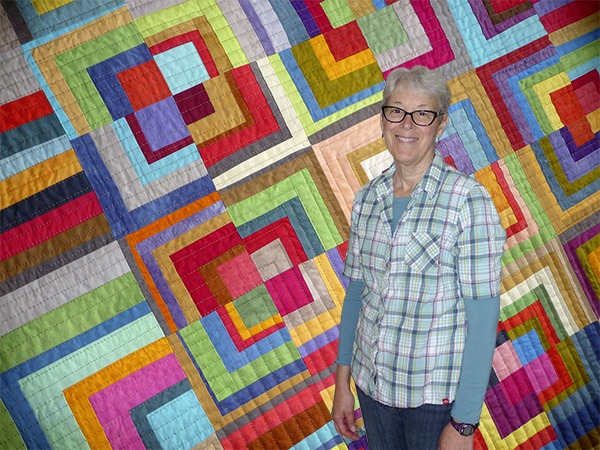For someone who remembers her high school Home Ec days fraught with sewing trials and tribulations, Marla Varner has turned an about-face and now uses the art of quilting as an outlet for her creativity.
Varner, 60, put down her needles and thread as a teen and picked them back up again in 1992 when her friend Bonnie Bless-Boenish, a longtime Sequim teacher, suggested the two of them attend a class to learn how to craft a salmon-themed quilt.
“I started quilting about 20 years ago and initially did a lot of traditional quilting (with established patterns) until three or four years ago when I took a workshop from my friend and mentor Pat Oden because I admired her work,” Varner said. “I learned improvisational techniques where you focus on composition and I also began to dye my own fabric with her. I dabbled a bit with art quilts and never showed anything publicly until 2011-2012.”
Varner calls her fabrics her paints and she only uses cotton material and cotton thread plucked from her palette of scraps and rainbow array of bobbins.
“There’s something about the fabric, color and texture” in crafting her quilts, Varner said. A year ago, she took an art class taught by high school art teacher Martha Rudersdorf, focusing on shapes, designs, lines and composition.
“I could see lots of applications for my improvisational quilting work,” she said. “I start with an idea but I don’t use a pattern. I might do a rough sketch and plan colors but mostly I create a certain unit and see where that takes me. I work a lot on a design wall where I play around with it and use both traditional and freeform cuttings.”
Varner said she’s inspired by many different things, including something as imaginative as groups of completed Sudoku games pieced together in blocks to form a quilt.
About 18 months ago, Varner said she started paying attention to the Modern Quilt Guild, a group that was established nationally in 2009 and which has exploded to include 150 chapters and 4,000 members.
“Last fall I joined the Bainbridge Island Modern Quilt Guild and go monthly,” Varner said. “Modern quilting emphasizes quilts that are functional and esthetic and that feels like a better fit for me. There’s more use of negative space and use of solids versus prints. The pattern may be asymmetrical, minimalist or really bold. Originally with the modern quilting movement, you weren’t seeing much machine quilting but now, more and more quilters are mixing some of both — machine and hand stitching — on the same quilt.”
Last month Varner and a quilting friend bought a “big arm” sewing machine that allows for free motion quilting.
“Instead of feeding the material through a sewing foot, you control the speed and movement of the quilt so you can do all types of designs,” Varner explained, but admitted she has a fondness for her 1946 Singer treadle and flywheel model, plus several other old Singers, too.
“I pretty much use all hand-wheel/treadle machines because I like the idea of making modern quilts on antique machines. It’s that dichotomy. The old Singers are very accurate and so easy to work on. I really like I can take them apart and put them back together. I like the simplicity of using them,” Varner said.
Varner said the rewards of quilting are being able to express her creative outlet and in making something that will last for a hundred years. Quilting also is an social outlet — she’s been meeting weekly with a group of 10 other women for the past 20 years.
“For me, with improvisational quilting, it’s like a puzzle and I like puzzles, needing to work and solve them,” Varner said. “And there’s something tactile about quilting, too, and the endless possibilities of what I can do with each one. Fabric is my paint — it’s the art medium that I choose to work with and I do like that it’s functional and beautiful.”
Varner recently has stepped outside her comfort zone and entered five of her quilts in QuiltCon, a juried show that will be in Austin, Texas, in February, attracting some 10,000 quilters internationally.



